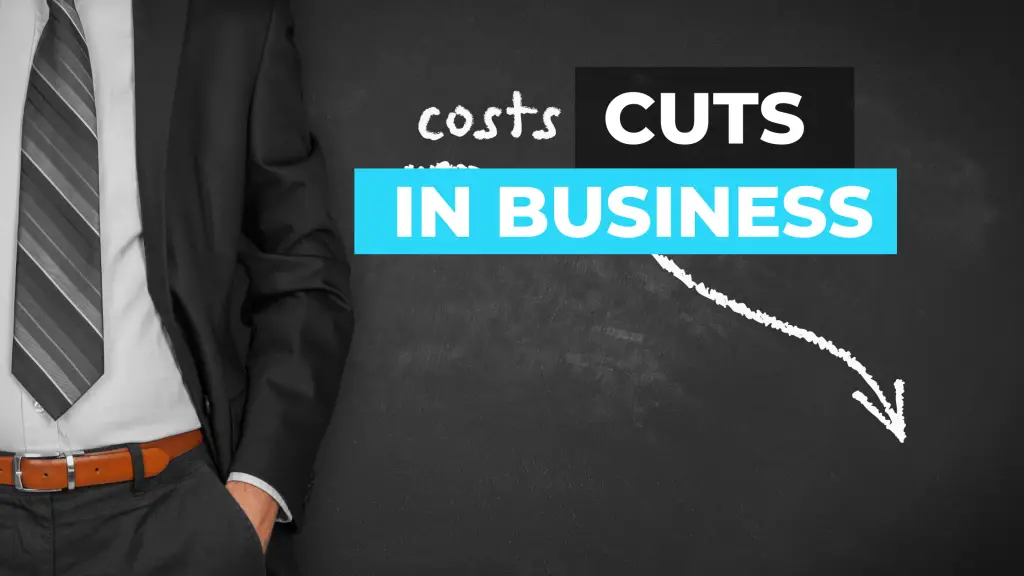How to Cut Costs in Business: The Ultimate Guide

Today we will be showing our ultimate guide on how to cut costs in business. As costs continue to rise, expenses can take a hefty chunk out of revenue. We review some tips that are sure to reduce costs in your daily business operations.
Evaluate all areas of spend
When it comes to cutting costs in business, you need to take a good hard look at all areas of expenditure to see where you can make savings. This may include reducing staff costs, expenses, or overheads. It is important to remember that making cuts in one area may have an impact on another, so you need to carefully consider all options before making any decisions.
Review all outgoing payments
In order to save money, you need to take a close look at all of your outgoing payments. This includes everything from your rent or mortgage to the cost of your office supplies.
You may be able to negotiate better terms with your landlord or find a more affordable office space. You can also shop around for better deals on office supplies and compare prices between different vendors.
In addition to looking at your monthly expenses, you should also review any contracts that you have in place. This includes contracts for services such as janitorial services, IT support, or marketing services.
If you are paying for a service that you are no longer using, be sure to cancel the contract. You may also be able to negotiate a lower rate if you are able to show that you are paying more than the going rate for the same service.
Assess whether current suppliers represent good value

When looking to cut costs, it’s important to first assess whether current suppliers represent good value. This can be done by evaluating supplier spending in relation to:
- Quality of goods or services
- Delivery times
- Levels of customer service
- Total cost (including any hidden costs such as delivery charges)
If it’s found that current suppliers are not offering good value, businesses should look to renegotiate terms or switch to a different supplier.
Analyze staff costs
When it comes to evaluating all areas of spend, businesses need to take a close look at their staff costs. This is one of the biggest areas of expenditure for most businesses, and there are a number of ways to cut costs in this area.
One way to cut staff costs is to review the salaries of your employees. While you may not be able to reduce everyone’s salary, you may be able to negotiate with some employees to take a pay cut. You could also look at reducing the hours of your staff members or introducing a pay freeze for a period of time.
Another way to reduce staff costs is to review the benefits you offer your employees. If you offer health insurance, for example, you could switch to a plan with a higher deductible. You could also consider reducing or eliminating other benefits, such as retirement plans or bonuses.
Finally, you could also look at reducing the number of staff members you have. If you have positions that are not essential to your business, you may be able to eliminate them. You could also offer early retirement packages or voluntary redundancy packages to encourage staff members to leave voluntarily.
Look for ways to generate additional income

There are a lot of ways to cut costs in business, but one of the most effective ways is to generate additional income. This can be done in a number of ways, but some of the most common include finding new customers, increasing sales to existing customers, or increasing prices. Let’s take a closer look at each of these.
Review the current pricing strategy
Are you charging enough for your products or services? If your prices are too low, you may not be making the profit you need to sustain your business. However, if your prices are too high, you may be making it difficult for customers to justify the purchase. Take a close look at your pricing strategy to see if there is room to increase prices without negatively impacting sales. You might also consider ways to offer discounts or packages that still allow you to generate the income you need.
Consider ways to increase customer spend
There are a number of ways to increase customer spend, and the most effective approach will vary depending on your business model and target market. However, some general strategies to consider include upselling, cross-selling, and bundle selling.
Upselling is the practice of convincing customers to purchase a higher-priced item or upgrade to a more expensive version of what they were originally interested in. For example, a clothing retailer might suggest a pair of earrings to go with a dress that a customer is trying on.
Cross-selling is similar to upselling but involves selling complementary products rather than upgraded versions of the same product. For example, a car salesperson might suggest adding rustproofing or undercoating to a vehicle purchase.
Bundle selling is when businesses offer products or services in pre-set packages at a discounted price. This is often used as a way to increase average order size, as customers are more likely to add items to their cart when they are already getting a deal on them.
Review product mix
Be sure to review your product mix on a regular basis to ensure that you are generating the highest possible margins. The most effective way to do this is to track your costs for each product and compare them to your selling prices. If you find that you are selling a product for less than it costs you to produce it, you may want to consider eliminating that product from your lineup or raising your prices.
Review overheads

It is essential for businesses to keep overheads low without comprising the quality of their product or service. Many businesses choose to cut costs by outsourcing, automating, or streamlining their processes. Let’s take a look at how businesses can cut costs without compromising quality.
Analyze energy costs
As a business owner, you’re always looking for ways to cut costs and maximize profits. One area you may not have considered is your overhead expenses. By taking a closer look at your overhead costs, you can find ways to reduce them and improve your bottom line.
One of the biggest overhead expenses for many businesses is energy costs. If you’re not using energy-efficient lighting and appliances, you’re likely spending more than you need to on your monthly energy bill. Taking steps to upgrade to energy-efficient options can help you save money in the long run.
You should also take a close look at your office space. If you’re paying for more space than you need, consider downsizing to a smaller office or sharing space with another business. This can help you reduce your rent or mortgage payments, as well as other associated costs such as insurance and utilities.
It’s also important to review your insurance coverage and make sure you’re not overpaying for coverage that doesn’t meet your needs. You may be able to get by with less coverage than you have now or switch to a different type of policy that better suits your business.
By taking the time to analyze your overhead costs, you can find ways to reduce them and improve your bottom line. By making even small changes, you can save big money in the long run.
Check out our article that reviews The Importance of Small Business Accounting for Maximum Success
Review property costs
As a business owner, it’s important to keep an eye on your bottom line. One way to do this is to regularly review your property costs. Here are some tips on how to cut costs in this area:
1. Review your current lease agreement: Are you paying more than you need to for your current office or retail space? If so, it may be time to renegotiate your lease or look for a new property.
2. Shop around for insurance: Take the time to comparison shop for business insurance. You may be able to get a better rate by switching providers.
3. Review your utility bills: Are you paying too much for heat, water, and electricity? There may be ways to reduce your costs by making energy-efficient upgrades to your property or changing the way you use utilities.
4. Get rid of unused space: If you have extra space that you’re not using, consider subletting it or giving it up altogether. This will save you money on rent or mortgage payments.
By taking the time to review your property costs, you can save money and use those savings to improve other areas of your business.
Consider outsourcing certain functions
Many businesses choose to outsource certain functions in order to save money. When evaluating which functions to outsource, businesses should consider a number of factors, including the cost of the service, the quality of the service, and the impact on business operations.
Outsourcing can be a great way to save money on certain business functions, but it’s important to consider all of the factors before making a decision.
Implement cost-cutting measures

Before you can start cutting costs, you need to know where your business is currently spending money. Track your spending for at least two months to get a clear picture of where your money is going. Once you know where your business is spending money, you can start implementing cost-cutting measures.
Make changes to outgoing payments
Outgoing payments are one of the key areas that businesses can focus on when looking to cut costs. By negotiating better terms with suppliers, you can reduce the amount you’re paying out each month. This could involve anything from negotiating longer payment terms to agreeing to bulk discounts.
If you want to make changes to your outgoing payments, the first step is to take a close look at your current spending. Make a list of all the suppliers you’re using and the amount you’re paying them each month. Once you have this information, you can start to look for ways to reduce what you’re spending.
One way to do this is by negotiating better payment terms. If you’re currently paying your suppliers in full each month, see if you can agree to pay them in installments instead. This could help free up some cash flow and give you more flexibility when it comes to making payments.
Another option is to look for bulk discounts. If you’re buying large quantities of goods from a supplier, see if they’re willing to offer a discount for buying in bulk. This could help reduce your costs significantly over time.
Once you’ve looked at your options and found a few ways to cut costs, it’s time to start putting them into place. Begin by contacting your suppliers and negotiating new payment terms or discounts. Then, make sure you stick to your new budget and start seeing the savings add up over time.
Renegotiate with suppliers
Renegotiating with suppliers is one of the most effective ways to reduce costs in your business. If you have been working with the same suppliers for a while, it is likely that you are paying more than you need to. By renegotiating your contracts, you can bring your costs down without compromising on quality or service.
There are a few things to keep in mind when renegotiating with suppliers:
- Make sure you are clear about what you want to achieve. Do you want to lower prices, improve quality, or both?
- Do your homework and know what other businesses are paying for similar products or services. This will give you a good starting point for negotiating.
- Be willing to walk away if the supplier is not willing to meet your needs. There are plenty of other suppliers out there who will be happy to work with you.
Renegotiating your contracts can be a time-consuming process, but it is well worth the effort if it means reducing your costs and increasing your profits.
Reduce staff costs
One of the most effective ways to reduce costs in a business is to reduce staff costs. This can be done by reducing the number of staff members, or by reducing the salaries and/or hours of existing staff members.
Another way to reduce staff costs is to use contingent workers, such as temp workers or independent contractors. Contingent workers are typically paid less than regular full-time employees, so using them can help to reduce labor costs.
Finally, businesses can save money by improving productivity and efficiency. This can be done by investing in technology and training, as well as by implementing better management practices.
Monitor results of How to Cut Costs in Business

You have to know where you are spending your money in order to save. Track all of your expenses for one month so you have a good idea of where your money is going. After that, start looking for ways to cut costs. You may be surprised at how much money you can save by doing things like shopping around for better prices, negotiating with vendors, and looking for ways to cut waste.
Review cost-cutting measures regularly
It’s important to review your cost-cutting measures on a regular basis. This will help you to see how effective they are and whether any changes need to be made. You should also review your costs periodically to make sure that you are still on track.
If you find that your costs are rising, you may need to make some changes to your cost-cutting measures. For example, if you find that you are spending more on raw materials, you may need to renegotiate your contract with your suppliers.
It’s also important to keep an eye on your competitors. If they start cutting their costs, then you may need to match their prices or offer a better quality product or service in order to remain competitive.
Make changes where necessary
If you want to save money in your business, you need to be constantly monitoring your results and making changes where necessary. There are a few key areas that you can focus on in order to cut costs:
Reduce staff costs: One of the biggest expenses for any business is staff costs. If you can reduce these costs, it will have a big impact on your bottom line. There are a few ways to do this:
- Reduce the number of employees you have.
- Use part-time or freelance employees instead of full-time staff.
- Outsource some of your work to contractors or other businesses.
Reduce your inventory costs: Another big expense for businesses is inventory costs. If you can reduce the amount of money you spend on inventory, it will have a big impact on your bottom line. There are a few ways to do this:
- Reduce the amount of inventory you keep on hand.
- Turn over your inventory faster by selling it more quickly.
- Get better deals on inventory by negotiating with suppliers.
Reduce your marketing costs: Marketing can be a big expense for businesses, but it doesn’t have to be. There are a few ways to reduce your marketing costs:
- Do your own marketing instead of hiring someone else to do it.
- Use free or low-cost marketing channels like social media or SEO.
- Create your own marketing materials instead of buying them from a supplier.
You may find yourself in need of additional funds for your business. Check out some proven ways How to Get Startup Business Funding.







